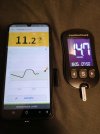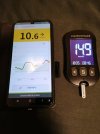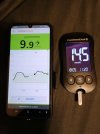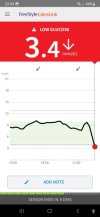jackdinn
Member
- Relationship to Diabetes
- Type 1
Hi all,
Yea I'm sure you will say "You know that there is a lag between the interstitial fluid & blood?" and yea i know but I'm not talking about a lag I'm talking about a -5 mmol/L (yep -5 is quite common) continual difference.
Right at the moment the CGM says I'm level(ish) at just over 10 but the finger prick says im at 15.
It will remain 5 to 6 points lower than my finger prick for the rest of the life of this particular libre tag. The next tag maybe a little better it may be worse.
I have just started this tag, but it has been "soaking" for 2 days already.
(o yea the time on my CareSens was an hour behind the phones time in the first pic, i don't use it much at all and i didn't notice the summertime hour had not been altered)


I was going to post this question last month but my previous tag was actually pretty close to the finger prick (about -2) so i didn't, but this new tag is back to the normal -5/ -6
Yea I'm sure you will say "You know that there is a lag between the interstitial fluid & blood?" and yea i know but I'm not talking about a lag I'm talking about a -5 mmol/L (yep -5 is quite common) continual difference.
Right at the moment the CGM says I'm level(ish) at just over 10 but the finger prick says im at 15.
It will remain 5 to 6 points lower than my finger prick for the rest of the life of this particular libre tag. The next tag maybe a little better it may be worse.
I have just started this tag, but it has been "soaking" for 2 days already.
(o yea the time on my CareSens was an hour behind the phones time in the first pic, i don't use it much at all and i didn't notice the summertime hour had not been altered)


I was going to post this question last month but my previous tag was actually pretty close to the finger prick (about -2) so i didn't, but this new tag is back to the normal -5/ -6


